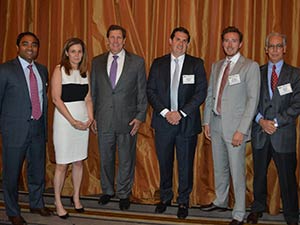
The Money Game: The Strategies Large Funds Are Using in the Wake of Global Uncertainty
- Published
- Jun 29, 2016
- Share
A version of this article was first published by Real Estate Weekly Online on June 22.
 Panelists and attendees of IMN’s 17th Annual U.S. Real Estate Opportunity and Private Funds Investing Forum likely had more cash on hand than most small countries. But how are macro-economic trends impacting how that capital is being deployed?
Panelists and attendees of IMN’s 17th Annual U.S. Real Estate Opportunity and Private Funds Investing Forum likely had more cash on hand than most small countries. But how are macro-economic trends impacting how that capital is being deployed?
Partner-in-charge of EisnerAmper’s real estate group, joined some of the real estate industry’s largest funds for a plenary session to discuss how they’re approaching the market today—and their strategies were as varied as their companies.
Angelo, Gordon & Co managing director Dana Roffman reported her firm is taking the same stance as it always has—looking for value-add situations where there are opportunities to reposition. It continues to approach the market via joint ventures with local operating partners, she said.
Almanac Realty Investors also continues to take the path most familiar, noted partner Pike Aloian: investing in companies with smart-growth business plans and putting capital in the hands of entrepreneurs who know how to invest it across various markets.
The single-family home market, which sprung up during the economic crisis, has experienced dwindling opportunities, said Starwood Capital Group senior vice president Brendan Bogan. However, you can still grab 5.5% to 6% net yields on the Multiple Listing Service, with margins just as good as multifamily. In those investments, Starwood is focusing on Sunbelt markets with better tax regimes, growing population, and job increases.
The winds have shifted for NorthStar Asset Management Group, which today is a net seller of owned real estate, noted managing director Sujan Patel.
“We took advantage of four to five years of buying, and now our focus is on monetizing these investments and raising cash for more opportunity coming,” he said, predicting better acquisitions on the horizon.
The sole reason for all of the regulations in the financial sector is to make sure the over-exuberance that caused the global financial crisis doesn’t happen again, said Mack Real Estate Credit Strategies CIO and managing member Peter Sotoloff.
Despite this, Mack’s average loan today is over $100 million, he continued, with a pipeline that’s “off the charts.” The trick: being thoughtful, understanding the markets Mack is in, and knowing who the company is dealing with. Even in a negative-to-zero interest rate environment, “we still see a good basis, good sponsors, and good lending opportunities.”
“Is there any market you’re not looking at?" Weissenberg asked, to which the panelists offered sectors like high-end condos and various pockets of lodging on a market-by-market basis.
“The last 3 or 4 years, it was a lot easier for all of us, as the wind was at our backs,” Patel pointed out. “Today, there is opportunity in every market, but it’s back to the street corner you’re investing on and the quality of asset you’re investing in.”
Roffman added that it’s about having a conservative eye, and Angelo Gordon is looking for deals in which it could find situations, like when it was able to recap a CMBS loan of a 2006-2007 vintage maturing in San Francisco.
“We’ve been able to capitalize on some really great opportunities,” she said. “It’s hard to red-line markets for being overpriced, because a lot of times, there are great situations within them and you have to seek them out.”
Brogan said Starwood is focused on cash flow and de-risking its residual through significant cash-on-cash yields—and because of that, the firm is spending most of its time in the apartment sector, which offers north of double digits on those cash-on-cash yields. It also has an operation in Europe, where there’s a different set of opportunities, particularly on distressed assets.
“That said, it seems that Europe seems to be the place to put risk capital,” Weissenberg noted, asking the panelists about their overseas strategies.
NorthStar’s European strategy is basic: focusing on core office in the U.K.,France, Germany, and a few other major markets, Patel said. Three years ago, it took advantage of portfolio acquisitions to scale quickly vs. single-asset trades, then spun out a European office REIT.
“It’s an interesting opportunity depending on the type of capital you have, as it’s a little more yield-oriented,” he added.
Sotoloff expressed concerns about banks still over-lending and mispricing capital for key clients in Europe. From an alternative lender standpoint, there’s still better relative value in the U.S., he noted. “It’s much better than Europe, which flip flops and switches.”
Angelo Gordon, which has been in Europe for over 5 years, has just raised a fund shy of $600 million dedicated for Europe. Roffman said the firm is taking its strategy of joint venturing with local experts there, focusing on distress, value-add, and core-plus opportunities.
“How about the volatility today, from banking regulations to terrorism around the globe?” Weissenberg asked. “Are you changing your investment strategy?
“We’re all in the business of raising capital to make good investments in commercial real estate,” Patel responded. “The volatility is a good thing for our business. The key is having capital on hand during those times to invest. Taking advantage of opportunities that present themselves in this volatility is the driving factor behind why we’re selling some of our assets.”
Brogan said that Starwood is thinking “long and hard” about certain markets, especially since there’s a threat of overbuilding in the apartment space. Instead, it shifted its interest to the suburbs, because rents were affordable and there was undersupply stemming from the financial crisis. On the office side, it started looking at secondary cities like Nashville, Raleigh, Portland, and Charlotte, “where there’s a lot of wind at their backs and undersupply.” These markets are now heating up, he noted, “and we’ll be in and out of there.”
“So what inning is commercial real estate in?” Weissenberg asked.
Sotoloff said while we’re deep in the investment cycle, it’s been different from past cycles, given the negative-to-zero interest rate environment, problems globally, and pension funds readying for a world of hurt. However, he doesn’t expect a massive crash on the horizon.
“There’s $252 billion of private equity sitting on the sidelines waiting to be deployed at a moment’s notice when things blow up,” he pointed out.
Aloian ventured the market is in the fifth or sixth inning. Most property types he’s following seem to be performing well, fundamentals are good, the economy is bubbling along with some growth, and interest rates are benign, creating attractive investment opportunities, he said.
At EisnerAmper’s recent West Coast Private Equity Summit, Weissenberg noted that the term “FOMO”—fear of missing out—is now being replaced by “FOOP,” or fear of overpaying. What about valuations?
Brogan said they’re beginning to creep up in certain markets, and Starwood is tracking discount-to-replacement costs, which keep getting tighter and forcing the firm to be more careful in asset selection. But that’s not what’s concerns him the most. Instead, it’s situations like Brexit and how it might impact investment in Europe.
“Global externalities will be keeping us up at night,” he said.
“There’s no shortage of things to worry about, for sure,” Aloian added. “We have global terrorism and a scary political environment in our country. What we try to do is invest in good companies, keep leverage ratios low, generate recurring cash flow, and set ourselves up to grab opportunities when we see them.”
Patel predicted there will be a major world event that will be a shock to the system, “but I don’t spend too much time worrying because we don’t know when and where it will happen.” Instead, it’s about staying ahead of the changes, whether it’s financial regulation, tax reform, fiscal policies, or the technology that’s reshaping the industry and how we live, work, and play.
“Be conservative and optimistic at the same time,” concluded Roffman.
Contact EisnerAmper
If you have any questions, we'd like to hear from you.
Receive the latest business insights, analysis, and perspectives from EisnerAmper professionals.











